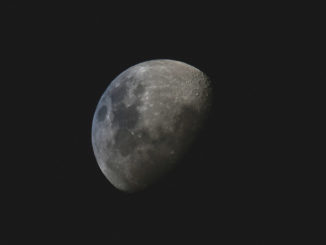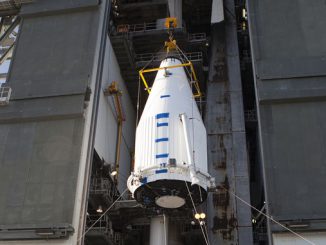
Hardware problems that cropped up earlier this month on the Hubble Space Telescope, now approaching the 31st anniversary of its launch, are the latest signs the observatory is showing its age.
Hubble went into a safe mode March 7 due to a software error, and ground teams restored the observatory to full operations six days later. But efforts to recover the telescope revealed two other problems.
One glitch involved the aperture door at the forward end of the telescope, which was supposed to close when Hubble went into safe mode to ensure bright sunlight did not damage sensitive internal optics. Then engineers discovered a voltage alarm on Hubble’s most-used scientific instrument, named Wide Field Camera 3.
Paul Hertz, head of NASA’s astrophysics division, said March 15 that both issues are likely related to aging hardware on Hubble.
“We had a software error, and then we had two places where we found some aging spacecraft issues,” Hertz said in a presentation to NASA’s Astrophysics Advisory Committee.
The software bug that triggered the safe mode March 7 came from the spacecraft’s main computer. Ground teams uploaded new software to the computer earlier this year to help compensate for fluctuations in one of Hubble’s gyroscopes, which measure the direction and rate of the spacecraft’s movement when it turns to point toward distant galaxies, stars, and planets to collect scientific data and imagery.
Hertz said the new software was designed to allow Hubble to more efficiently turn, or slew, from one scientific target to another as it orbits 340 miles (550 kilometers) above Earth. The software was also supposed to mitigate a problem with noise in one of the Hubble’s three functioning gyroscopes.
Hubble’s gyroscopes are degrading after astronauts on the space shuttle Atlantis replaced all six gyros on the most recent servicing mission to the observatory in 2009. Three of the gyros are still in use, and Hubble needs all three for regular operations.
Engineers have devised ways to continue some of the telescope’s observations with just one gyro, but that would come with limitations in where Hubble could point to make astronomical observations.
Ground teams restored Hubble to scientific operations March 11 after removing the suspect software code from the computer. NASA said engineers will update the software enhancement to upload to the spacecraft again in the future.
While the gyros themselves are aging, the safe mode event earlier this month also revealed other signs that Hubble is in the twilight of its service life.
The aperture door at the top of the telescope failed to automatically close when Hubble went into safe mode.
“It turns out that the primary side door motor has failed — just an age thing — since 2009,” Hertz said. “So we have switched the door over to the redundant motor, which we have confirmed is fully functioning.”
Hertz said the door motors are original parts from Hubble’s construction in the 1980s, and were never serviced on the five space shuttle maintenance and upgrade missions NASA sent to the observatory.
The only time ground teams would have discovered the door motor failure was when the aperture door was supposed to close. The last time the door opened and shut was before and after the final shuttle servicing flight in 2009.
“The motor dying does not interrupt operation, and if the redundant motor dies with the door open, we’re fine,” Hertz said. “That’s the preferred failure mode.”

During efforts to reactivate Hubble’s most-used science camera, named Wide Field Camera 3, engineers detected a low voltage reading inside the instrument.
Hertz said the reading was slightly below a preset low voltage limit, causing teams to temporarily halt the reactivation of the camera while pressing ahead with the resumption of scientific observations using Hubble’s other science instruments.
Like the gyros and door motor, Hertz said NASA has determined the voltage issue inside Wide Field Camera 3 is also associated with its age. Astronauts installed the camera into Hubble on the 2009 shuttle servicing mission.
“One of the voltages has been creeping down a little bit, so we have lowered that voltage limit to accommodate the aging instrument,” Hertz said.
Engineers restored the camera to service March 13, bringing Hubble back into full operations.
The famed Hubble Space Telescope was developed by NASA with contributions from the European Space Agency. With the space shuttles retired, NASA is preparing for the end of Hubble operations in the coming years.
NASA’s next advanced space-based observatory — the James Webb Space Telescope — is set for launch in October to extend the vision of Hubble with a larger mirror and a more sophisticated suite of scientific instruments.
Last year, during virtual celebrations marking the 30th anniversary of Hubble’s launch, mission managers said they expected to get at least five more years of worthwhile astronomical observations with the long-lived observatory.
Email the author.
Follow Stephen Clark on Twitter: @StephenClark1.



